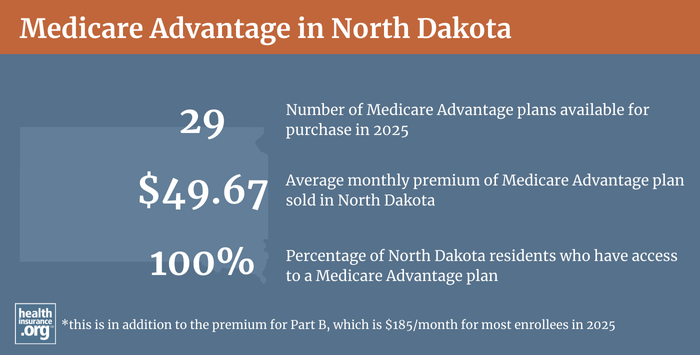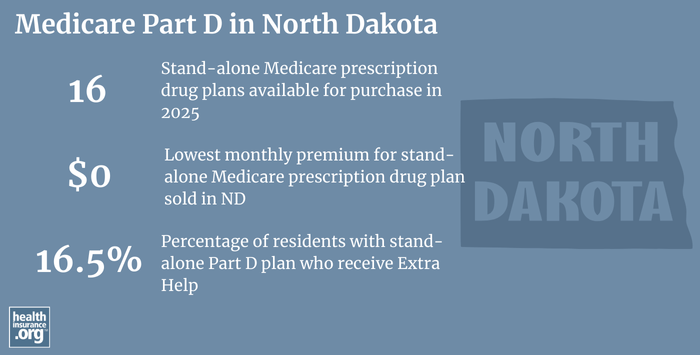
Medicare in North Dakota
Original Medicare, Medicare Advantage, Part D prescription drug, and Medigap coverage in North Dakota
Key takeaways
- More than 148,000 residents are enrolled in Medicare in North Dakota.1
- 35% of North Dakota Medicare beneficiaries are enrolled in Medicare Advantage plans.1
- There are Medicare Advantage plans available throughout North Dakota, with plan availability ranging from county to county.2
- There are 16 stand-alone Medicare Part D prescription plans available in North Dakota in 2025, with premiums starting at $0 per month.3

North Dakota Medicare enrollment
148,174 people were covered by Medicare in North Dakota as of September 2024,1 amounting to about 17% of the state’s population with Medicare coverage.4
Most Americans become eligible for Medicare when they turn 65. But nationwide, there are over 7 million people under the age of 65 who are covered by Medicare, accounting for about 11% of all Medicare beneficiaries.5 This is because Medicare eligibility is also triggered once a person has been receiving disability benefits for 24 months, or has kidney failure or ALS. In North Dakota, only about 9% of Medicare beneficiaries — a little more than than 13,000 people — are under age 65.1
Medicare options
Medicare beneficiaries have choices when it comes to how they access Medicare coverage. The first choice is between Medicare Advantage, where coverage is provided through private Medicare Advantage plans, or Original Medicare, where medical care is paid for directly by the federal government. Medicare beneficiaries also have options around Medigap policies and Medicare Part D (prescription drug) coverage.
Original Medicare includes Medicare Parts A and B. Medicare Part A (also called hospital insurance) helps pay for inpatient stays, like at a hospital, skilled nursing facility, or hospice center. Medicare Part B (also called medical insurance) helps pay for outpatient care like doctor visits, durable medical equipment, and preventive healthcare services, including some vaccinations.
Medicare Advantage includes all of the basic coverage of Medicare Parts A and B, and these plans generally include additional benefits — such as prescription drug and dental coverage — for a single monthly premium.
Learn about Medicare plan options in North Dakota by contacting a licensed agent.



Explore our other comprehensive guides to coverage in North Dakota

The ACA Marketplace allows individuals and families to shop for and enroll in ACA-compliant health insurance plans. Subsidies may be available based on household income to help lower costs.
Learn about the health insurance Marketplace in North Dakota.


Hoping to improve your smile? Dental insurance may be a smart addition to your health coverage. Our guide explores dental coverage options in North Dakota.


Learn about North Dakota’s Medicaid expansion, the state’s Medicaid enrollment and Medicaid eligibility.


Short-term health plans provide temporary health insurance for consumers who may find themselves without comprehensive coverage. Learn more about short-term plan availability in North Dakota.
Learn about short-term insurance regulations in North Dakota.

Frequently asked questions about Medicare in North Dakota
What is Medicare Advantage?
Medicare Advantage plans are offered by private insurers, so plan availability varies from one area to another. There are Medicare Advantage plans for sale in 2025 in all 53 counties in North Dakota, but some counties in western North Dakota have just three plans available, while residents in Burleigh County can select from among 22 different Medicare Advantage plans.2
As of September 2024, about 35% of North Dakota Medicare beneficiaries were enrolled in Medicare Advantage.1 Nationwide, the average was above 50% at that point.5
The other 65% of North Dakota Medicare beneficiaries were enrolled in Original Medicare as of September 2024.1
Medicare’s annual election period (October 15 to December 7 each year) allows Medicare beneficiaries the chance to switch between Medicare Advantage and Original Medicare (and add, drop, or switch to a different Medicare Part D prescription plan). People who are already enrolled in Medicare Advantage plans also have the option to switch to a different Advantage plan or to Original Medicare during the Medicare Advantage open enrollment period, which runs from January 1 to March 31.

Medigap enrollment and regulations in North Dakota
According to AHIP, 50,922 Utah residents were enrolled in Medigap plans in 2023,6 to supplement their Original Medicare coverage.
Learn how Medigap plans are regulated and standardized.
Federal rules require Medigap insurers to offer plans on a guaranteed-issue basis during an enrollee’s open enrollment period, which begins when the person is at least 65 years old and enrolled in Medicare Part B (and Part A; you have to be enrolled in both to obtain Medigap). But federal rules do not guarantee access to Medigap plans for people under age 65.
No access to Medigap for new enrollees under age 65
Many states require Medigap insurers to make coverage available to applicants under age 65, but North Dakota does not. However, North Dakota has historically offered high-risk pool coverage (CHAND) to Medicare beneficiaries under age 65 who were unable to obtain private Medigap coverage.
However, North Dakota enacted legislation in 20257 that ended new enrollments in the high-risk pool as of May 1, 2025. Coverage for existing enrollees will terminate by the end of 2025.8
Existing enrollees who lose their CHAND coverage will have guaranteed issue access to Medigap coverage (Plans A, B, C, F, high-deductible F, G, K, or L.9
But the legislation did not ensure any form of guaranteed-issue access to Medigap for other North Dakota Medicare beneficiaries under age 65. As of October 2025, no private Medigap plans were available in North Dakota for beneficiaries under age 65.10
What is Medicare Part D?
Original Medicare does not provide coverage for outpatient prescription drugs.
Some beneficiaries have supplemental coverage from a current or former employer that includes prescription coverage.
But Medicare Part D, created under the Medicare Modernization Act of 2003, provides drug coverage for Medicare beneficiaries who do not have another source of coverage for prescription costs. As of late 2024, nearly 55 million people, nationwide, had Part D coverage.5
Medicare beneficiaries can buy Part D plans on a stand-alone basis, or obtain Part D coverage integrated with a Medicare Advantage plan (not all Medicare Advantage plans include Part D benefits, but most do).
Medicare Part D enrollment is available when a person is first eligible for Medicare (or loses access to other creditable drug coverage later on), and plan changes can be made each year during the annual open enrollment period from October 15 to December 7, with coverage effective the following January.
There are 16 stand-alone Medicare Part D plans for sale in North Dakota in 2025, with premiums that start at $0/month.3
As of September 2024, 78,884 Medicare beneficiaries in North Dakota had stand-alone Medicare Part D plans, and another 36,790 had Medicare Advantage plans that included integrated Medicare Part D coverage.1

What additional resources are available for Medicare beneficiaries and their caregivers in North Dakota?
Need help with Medicare enrollment in North Dakota or California, or have questions about Medicare eligibility in North Dakota?
You can contact SHIC, the North Dakota State Health Insurance Counseling Program.
The state’s department of insurance website includes several informational pages that can help to guide you with your Medicare application in North Dakota:
- Medicare Advantage plans in North Dakota
- General info about Medicare Supplement plans (Medigap) and North Dakota Medicare Supplement FAQs
- Medicare Part D plans in North Dakota
The Medicare Rights Center website provides information geared to Medicare beneficiaries, caregivers, and professionals.
Louise Norris is an individual health insurance broker who has been writing about health insurance and health reform since 2006. She has written dozens of opinions and educational pieces about the Affordable Care Act for healthinsurance.org.

Looking for more information about other options in your state?
Need help navigating health insurance options in North dakota?
Explore more resources for options in ND including ACA coverage, short-term health insurance, dental and Medicaid.
Speak to a sales agent at a licensed insurance agency.
Footnotes
- “Medicare Monthly Enrollment – North Dakota.” Centers for Medicare & Medicaid Services Data. Accessed January, 2025. ⤶ ⤶ ⤶ ⤶ ⤶ ⤶ ⤶
- ”Medicare Advantage 2025 Spotlight: First Look” KFF.org Nov. 15, 2024 ⤶ ⤶
- ”Fact Sheet: Medicare Open Enrollment for 2025” (104) Centers for Medicare & Medicaid Services. Sep. 27, 2024 ⤶ ⤶
- U.S. Census Bureau Quick Facts: United States & North Dakota.” U.S. Census Bureau, July 2024. ⤶
- “Medicare Monthly Enrollment – US” Centers for Medicare & Medicaid Services Data. Accessed January, 2025. ⤶ ⤶ ⤶
- “The State of Medicare Supplement Coverage” AHIP. May 2025. Accessed Oct. 5, 2025 ⤶
- “North Dakota SB2032” BillTrack50. Enacted Mar. 18, 2025 ⤶
- ”Special Notice: CHAND Coverage Ends” North Dakota CHAND. Accessed Oct. 5, 2025 ⤶
- ”North Dakota SB2032” BillTrack50. Enacted Mar. 18, 2025 ⤶
- ”Find a Medigap policy that works for you” Medicare.gov. Accessed Oct. 2, 2025 ⤶

